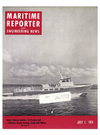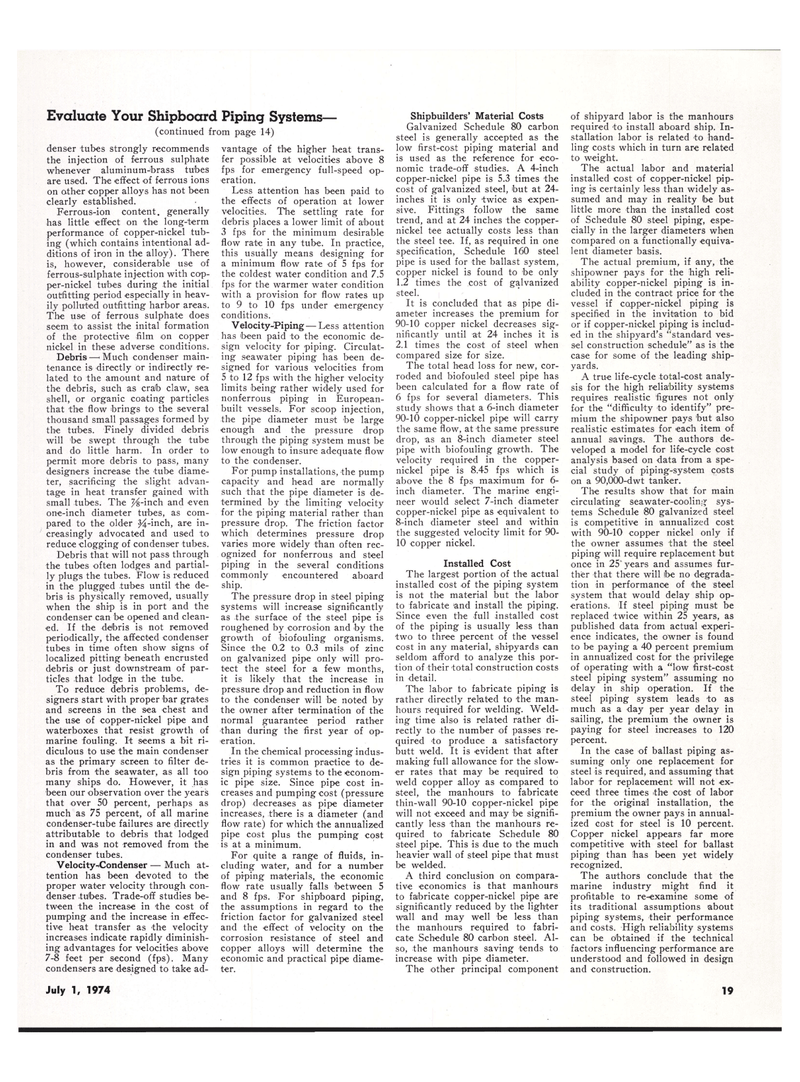
Page 13: of Maritime Reporter Magazine (July 1974)
Read this page in Pdf, Flash or Html5 edition of July 1974 Maritime Reporter Magazine
Evaluate Your Shipboard Piping Systems— (continued from page 14) denser tubes strongly recommends the injection of ferrous sulphate whenever aluminum-brass tubes are used. The effect of ferrous ions on other copper alloys has not been clearly established.
Ferrous-ion content, generally has little effect on the long-term performance of copper-nickel tub- ing (which contains intentional ad- ditions of iron in the alloy). There is, however, considerable use of ferrous-sulphate injection with cop- per-nickel tubes during the initial outfitting period especially in heav- ily polluted outfitting harbor areas.
The use of ferrous sulphate does seem to assist the inital formation of the protective film on copper nickel in these adverse conditions.
Debris —1 Much condenser main- tenance is directly or indirectly re- lated to the amount and nature of the debris, such as crab claw, sea shell, or organic coating particles that the flow brings to the several thousand small passages formed by the tubes. Finely divided debris will be swept through the tube and do little harm. In order to permit more debris to pass, many designers increase the tube diame- ter, sacrificing the slight advan- tage in heat transfer gained with small tubes. The %-inch and even one-inch diameter tubes, as com- pared to the older ^-inch, are in- creasingly advocated and used to reduce clogging of condenser tubes.
Debris that will not pass through the tubes often lodges and partial- ly plugs the tubes. Flow is reduced in the plugged tubes until the de- bris is physically removed, usually when the ship is in port and the condenser can be opened and clean- ed. If the debris is not removed periodically, the affected condenser tubes in time often show signs of localized pitting beneath encrusted debris or just downstream of par- ticles that lodge in the tube.
To reduce debris problems, de- signers start with proper bar grates and screens in the sea chest and the use of copper-nickel pipe and waterboxes that resist growth of marine fouling. It seems a bit ri- diculous to use the main condenser as the primary screen to filter de- bris from the seawater, as all too many ships do. However, it has been our observation over the years that over 50 percent, perhaps as much as 75 percent, of all marine condenser-tube failures are directly attributable to debris that lodged in and was not removed from the condenser tubes.
VelocitynCondenser — Much at- tention has been devoted to the proper water velocity through con- denser tubes. Trade-off studies be- tween the increase in the cost of pumping and the increase in effec- tive heat transfer as the velocity increases indicate rapidly diminish- ing advantages for velocities above 7-8 feet per second (fps). Many condensers are designed to take ad- vantage of the higher heat trans- fer possible at velocities above 8 fps for emergency full-speed op- eration.
Less attention has been paid to the effects of operation at lower velocities. The settling rate for debris places a lower limit of about 3 fps for the minimum desirable flow rate in any tube. In practice, this usually means designing for a minimum flow rate of 5 fps for the coldest water condition and 7.5 fps for the warmer water condition with a provision for flow rates up to 9 to 10 fps under emergency conditions.
Velocity-Piping— Less attention has been paid to the economic de- sign velocity for piping. Circulat- ing seawater piping has been de- signed for various velocities from 5 to 12 fps with the higher velocity limits being rather widely used for nonferrous piping in European- built vessels. For scoop injection, the pipe diameter must be large enough and the pressure drop through the piping system must be low enough to insure adequate flow to the condenser.
For pump installations, the pump capacity and head are normally such that the pipe diameter is de- termined by the limiting velocity for the piping material rather than pressure drop. The friction factor which determines pressure drop varies more widely than often rec- ognized for nonferrous and steel piping in the several conditions commonly encountered aboard ship.
The pressure drop in steel piping systems will increase significantly as the surface of the steel pipe is roughened by corrosion and by the growth of biofouling organisms.
Since the 0.2 to 0.3 mils of zinc on galvanized pipe only will pro- tect the steel for :a few months, it is likely that the increase in pressure drop and reduction in flow to the condenser will be noted by the owner after termination of the normal guarantee period rather than during the first year of op- eration.
In the chemical processing indus- tries it is common practice to de- sign piping systems to the econom- ic pipe size. Since pipe cost in- creases and pumping cost (pressure drop) decreases as pipe diameter increases, there is a diameter (and flow rate) for which the annualized pipe cost plus the pumping cost is at a minimum.
For quite a range of fluids, in- cluding water, and for a number of piping materials, the economic flow rate usually falls between 5 and 8 fps. For shipboard piping, the assumptions in regard to the friction factor for galvanized steel and the effect of velocity on the corrosion resistance of steel and copper alloys will determine the economic and practical pipe diame- ter.
Shipbuilders' Material Costs
Galvanized Schedule 80 carbon steel is generally accepted as the low first-cost piping material and is used as the reference for eco- nomic trade-off studies. A 4-inch copper-nickel pipe is 5.3 times the cost of galvanized steel, but at 24- inches it is only twice as expen- sive. Fittings follow the same trend, and at 24 inches the copper- nickel tee actually costs less than the steel tee. If, as required in one specification, Schedule 160 steel pipe is used for the ballast system, copper nickel is found to be only 1.2 times the cost of galvanized steel.
It is concluded that as pipe di- ameter increases the premium for 90-10 copper nickel decreases sig- nificantly until at 24 inches it is 2.1 times the cost of steel when compared size for size.
The total head loss for new, cor- roded and biofouled steel pipe has been calculated for a flow rate of 6 fps for several diameters. This study shows that a 6-inch diameter 90-10 copper-nickel pipe will carry the same flow, at the same pressure drop, 'as an 8-inch diameter steel pipe with biofouling growth. The velocity required in the copper- nickel pipe is 8.45 fps which is above the 8 fps maximum for 6- inch diameter. The marine engi- neer would select 7-inch diameter copper-nickel pipe as equivalent to 8-inch diameter steel and within the suggested velocity limit for 90- 10 copper nickel.
Installed Cost
The largest portion of the actual installed cost of the piping system is not the material but the labor to fabricate 'and install the piping.
Since even the full installed cost of the piping is usually less than two to three percent of the vessel cost in any material, shipyards can seldom afford to analyze this por- tion of their total construction costs in detail.
The labor to fabricate piping is rather directly related to the man- hours required for welding. Weld- ing time also is related rather di- rectly to the number of passes re- quired to produce a satisfactory butt weld. It is evident that after making full allowance for the slow- er rates that may be required to weld copper alloy as compared to steel, the manhours to fabricate thin-wall 90-10 copper-nickel pipe will not exceed and may be signifi- cantly less than the manhours re- quired to fabricate Schedule 80 steel pipe. This is due to the much heavier wall of steel pipe that must be welded.
A third conclusion on compara- tive economics is that manhours to fabricate copper-nickel pipe are significantly reduced by the lighter wall and may well be less than the manhours required to fabri- cate Schedule 80 carbon steel. Al- so, the manhours saving tends to increase with pipe diameter.
The other principal component of shipyard labor is the manhours required to install aboard ship. In- stallation labor is related to hand- ling costs which in turn are related to weight.
The actual labor and material installed cost of copper-nickel pip- ing is certainly less than widely as- sumed and may in reality be but little more than the installed cost of Schedule 80 steel piping, espe- cially in the larger diameters when compared on a functionally equiva- lent diameter basis.
The actual premium, if any, the shipowner pays for the high reli- ability copper-nickel piping is in- cluded in the contract price for the vessel if copper-nickel piping is specified in the invitation to bid or if copper-nickel piping is includ- ed in the shipyard's "standard ves- sel construction schedule" as is the case for some of the leading ship- yards.
A true life-cycle total-cost analy- sis for the high reliability systems requires realistic figures not only for the "difficulty to identify" pre- mium the shipowner pays but also realistic estimates for each item of annual savings. The authors de- veloped a model for life-cycle cost analysis based on data from a spe- cial study of piping-system costs on a 90,000-dwt tanker.
The results show that for main circulating seawater-cooling sys- tems Schedule 80 galvanized steel is competitive in 'annualized cost with 90-10 copper nickel only if the owner assumes that the steel piping will require replacement but once in 25 years and assumes fur- ther that there will be no degrada- tion in performance of the steel system that would delay ship op- erations. If steel piping must be replaced twice within 25 years, as published data from actual experi- ence indicates, the owner is found to be paying a 40 percent premium in annualized cost for the privilege of operating with a "low first-cost steel piping system" assuming no delay in ship operation. If the steel piping system leads to as much as a day per year delay in sailing, the premium the owner is paying for steel increases to 120 percent.
In the case of ballast piping as- suming only one replacement for steel is required, and assuming that labor for replacement will not ex- ceed three times the cost of labor for the original installation, the premium the owner pays in annual- ized cost for steel is 10 percent.
Copper nickel appears far more competitive with steel for ballast piping than has been yet widely recognized.
The authors conclude that the marine industry might find it profitable to re-examine some of its traditional assumptions about piping systems, their performance and costs. High reliability systems can be obtained if the technical factors influencing performance are understood and followed in design and construction.
July 1, 1974 13

 12
12

 14
14
